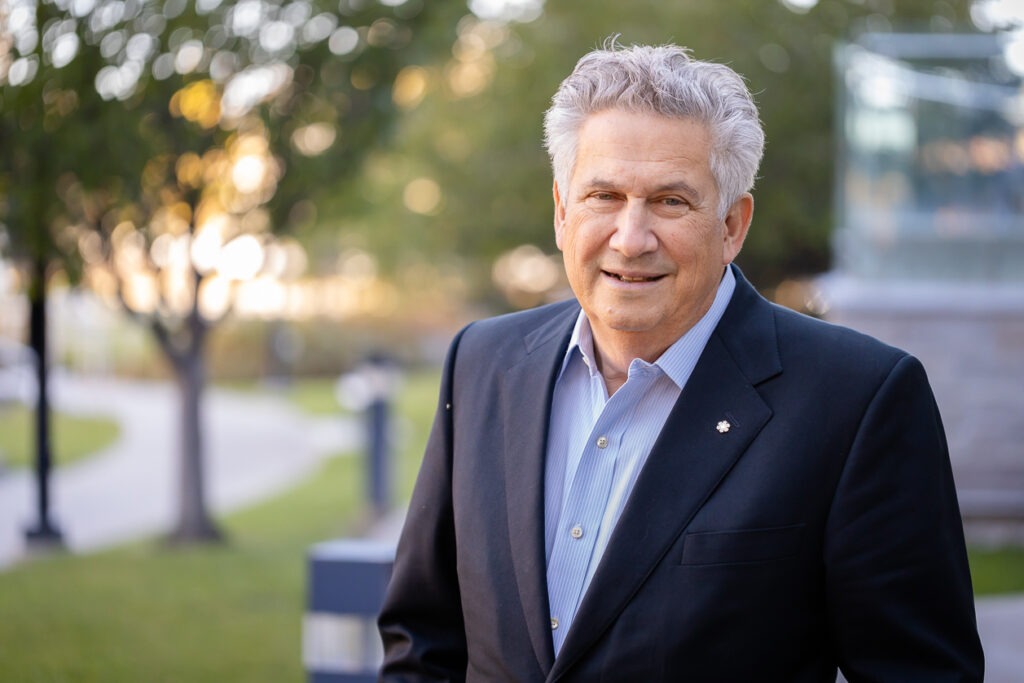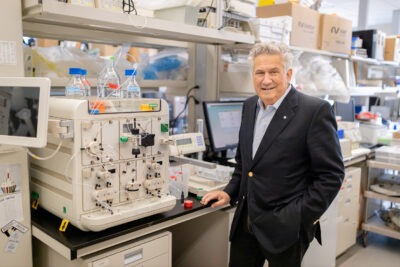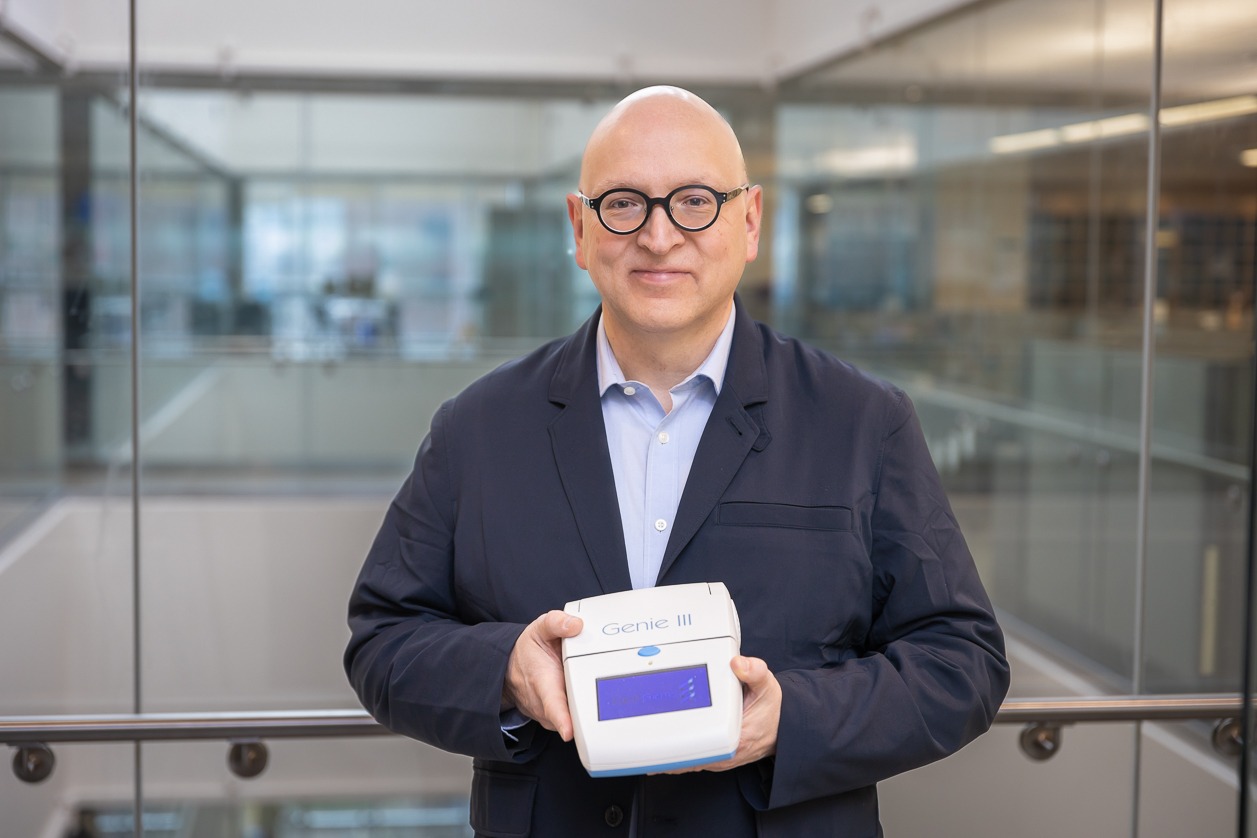
Nearing the “Holy Grail” of anti-clotting drugs
Blood clotting seems magical. You get a cut, your body stops the bleeding, makes a scab, and heals your wound. But it’s not magic – it’s science. And the more we know about how blood clotting works, the more we can treat damaging blood clots that cause stroke, heart attacks, and other serious medical conditions when they form abnormally inside the body.
Clots can heal but they can also harm
Hamilton Health Sciences (HHS) physician and researcher Dr. Jeffrey Weitz has dedicated his career to advancing the understanding and treatment of blood clotting disorders. His groundbreaking research has led to greater knowledge, new therapies, and improved patient outcomes. He’s on a mission to develop drugs that will stop bad clots with minimal side effects on the good clots needed for normal healing.
“In my years, I’ve seen a huge revolution in our ability to prevent and treat clotting disorders with the introduction of newer anticoagulants.”
The world-renowned hematologist is the executive director of the Thrombosis and Atherosclerosis Research Institute (TaARI), a joint initiative of HHS and McMaster University. Thrombosis means abnormal blood clotting and atherosclerosis refers to the buildup of fatty plaques inside arteries. Earlier this year, Weitz was named an Officer of the Order of Canada and a Distinguished Scientist of the American Heart Association in recognition of the impact of his work.
“At TaARI, we’ve always been focused on thrombosis,” says Weitz. “Abnormal blood clotting is responsible for one in four deaths worldwide. Thrombosis is the major underlying cause of stroke, heart attack, and deep vein thrombosis, all major causes of serious illness and death in Canada and around the globe.”
Dramatic improvements during his career

In his lab at the David Braley Research Institute, Dr. Weitz often uses this Fast Performance Liquid Chromatography machine for purifying proteins in blood.
Weitz has published hundreds of research papers over the last 40 years. His expertise makes him an in-demand speaker worldwide.
“We’ve had tremendous advances in our ability to prevent and treat these disorders,” says Weitz. “For example, when I first started in the 1980s, we were using systemic clot-busting agents like tPA to treat heart attacks, which has bleeding risks. Now patients go to the catheterization lab and have their blocked coronary arteries ballooned open and stents put in.”
Weitz also notes substantial improvements for patients who have a blockage in blood vessels in the brain leading to a stroke.
With the deepening understanding of how clots form comes the development of more targeted treatments and drugs with less risk of internal bleeding.
Revolutionizing prevention and treatment
If you picture the creation of a blood clot as a chain reaction, one step has to take place and then another and another, using different proteins and clotting factors that circulate in blood plasma. Older anticoagulant (“blood thinning”) drugs like warfarin reduce blood clotting by reducing the production of several clotting proteins. This is an effective way to prevent blood clot formation but it increases the risk of internal bleeding.
“In my years, I’ve seen a huge revolution in our ability to prevent and treat clotting disorders with the introduction of newer anticoagulants,” says Weitz. “A lot of my career has been focused on anticoagulants and antiplatelet agents.”
“Hamilton has been a terrific environment to do thrombosis research.”
Wietz’s research contributed to the development and introduction of a whole new class of anticoagulants in 2010. Direct oral anticoagulants, or DOACs, allow physicians to prevent and treat clots both at the level of deep vein thrombosis and pulmonary embolism (when clots in the deep veins of the leg break off andget stuck in the lungs), and also for the management of heart attack and stroke.
“The brand names are Xarelto and Eliquis,” says Weitz. “These two new drugs are given in fixed doses and don’t need the same kind of monitoring as warfarin so they’re easy to administer. But, even though they are safer than warfarin such that the risk of bleeding in the brain is reduced by 50 percent, bleeding is still the major problem.”
Today’s research is leading to even better treatments
What Weitz is working on now is interrupting the clotting process even earlier, with drugs that act on a protein called Factor XI (Factor eleven).
“Over the years we’ve learned much more about the clotting pathways that lead to good clot formation versus bad clot formation,” he says. “By targeting certain points in these pathways, we can, now, we hope, reduce or stop bad clot formation with minimal disruption of good clot formation. And that’s the holy grail of anticoagulation therapy.”
Research shows there’s a lot of promise and hope with factor eleven inhibitors. Clinical trials are underway with a number of factor eleven inhibitors under development.
“They’re at least as effective, if not more effective, than what we currently use, and certainly safer in terms of bleeding,” says Weitz.
Hamilton is the perfect home for this research
Weitz is involved in the full circle of research: identifying a patient issue, doing the research to better understand it, and then testing solutions in the lab and in clinical trials in patients. He calls it ‘Bridging bedside to bench and back.’
“Hamilton has been a terrific environment to do thrombosis research,” says Weitz. “There’s lots of support from the university and from the hospital. We have an excellent group of investigators. What has been incredible is getting the recognition, where companies come to you to ask you to work with them on these new drugs and to lead or be involved in the clinical trials.”
Very few researchers now work across the scope from bedside to the lab, animal models, and clinical trials. “People become specialized in one or the other of those areas,” says Weitz.
“But I think being able to bridge these disciplines means that you can really identify the problem at the bedside, test your hypothesis, and bring it right back to the bedside to test with patients. We have those capabilities in Hamilton and it makes us a leader in the thrombosis area nationally and internationally.”



